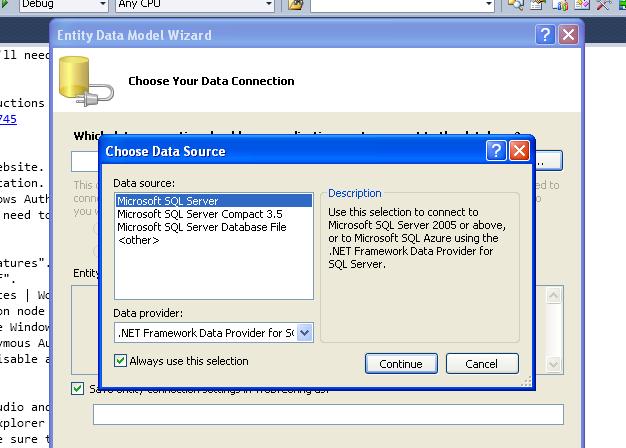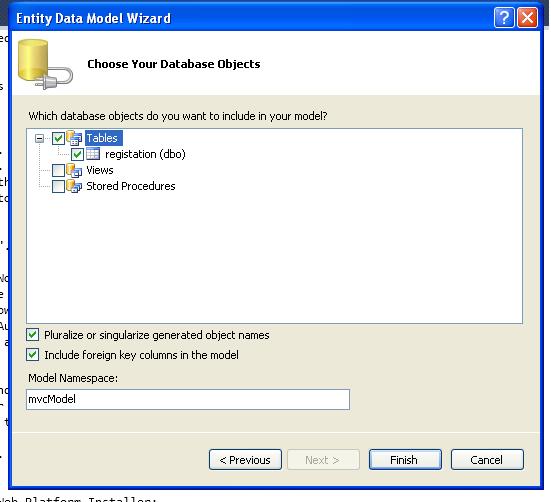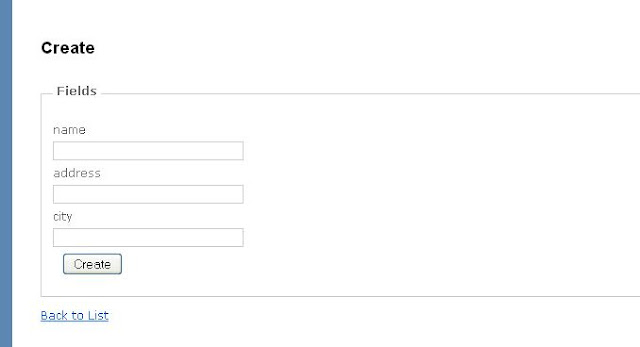Asp.net MVC 3 Database Connectivity
using Entity framework.
First open the VS
2010.
After this
Database Structure??? Create registration table in database.
Now add the New Entity Model.
Next Step
Next Step
Continue. Select the database that you have created in
Database.
After this
Select the Table name.
Now click on finish button.
Now create the new controller.. Right
click on controller and add new controller and type the controller
testcontroller. While creating controller choose controllerwithempyt read/write
mode.
[Note:-if we will create the test
controller then in views test folder automatically will be generated.]
Now
first build the solution….. For refreshing the model
Click on testcontroller look likes
Right click on index >>Add view >>
choose strong type view >> Choose Model class >> LIST
Then in Views folder >> Test
folder >> index.chtml will be created.
List
::
Coding:
private mvcEntities _db = new
mvcEntities();
public ActionResult
Index()
{
return
View(_db.registations.ToList());
}
Output:
Same as for create new view ,edit view
,delete view.
Create new:
// GET:
/work/Create
public ActionResult Create()
{
return
View();
}
//
// POST:
/work/Create
[HttpPost]
public ActionResult Create(registation
model)
{
try
{
if
(!ModelState.IsValid)
return
View();
_db.AddToregistation(model);
_db.SaveChanges();
return
RedirectToAction("Index");
//
TODO: Add insert logic here
}
catch
{
return
View();
}
}
Output screen
Edit View: Right click on edit View >>
ADD View >> strong type >>Edit
public ActionResult Edit(int
id)
{
var
RecordToEdit = (from m in
_db.registation
where m.id == id
select m).First();
return
View(RecordToEdit);
}
//
// POST:
/work/Edit/5
[HttpPost]
public ActionResult Edit(int
id,registation regtoedit)
{
try
{
//
TODO: Add update logic here
var
originalMovie = (from m in _db.registation
where m.id == regtoedit.id
//select m).First();
select m).First();
if
(!ModelState.IsValid)
return
View(originalMovie);
_db.ApplyPropertyChanges(originalMovie.EntityKey.EntitySetName,
regtoedit);
_db.SaveChanges();
return
RedirectToAction("Index");
}
catch
{
return
View();
}
}
//
Delete View: Right click on edit View >>
ADD View >> Partial View >>Delete
// GET:
/work/Delete/5
public ActionResult Delete(int
id)
{
var
originalMovie = (from m in _db.registation
where m.id == id
select m).First();
_db.DeleteObject(originalMovie);
_db.SaveChanges();
return
RedirectToAction("Index");
}
//
// POST:
/work/Delete/5
[HttpPost]
public ActionResult Delete(int
id,registation model)
{
try
{
var
originalMovie = (from m in _db.registation
where m.id == id
select m).First();
_db.DeleteObject(originalMovie);
_db.SaveChanges();
return
RedirectToAction("Index");
}
catch
{
return
View();
}
}
}
Now build the solution …
Thanks Happy Coding.

















Asp.net MVC 3 Entity framework
ReplyDelete